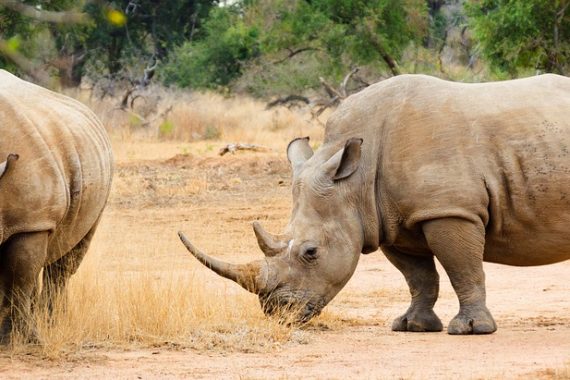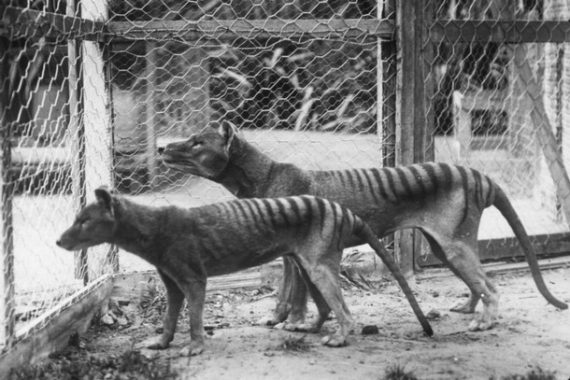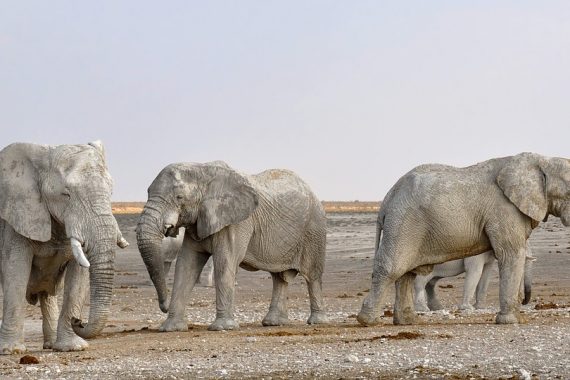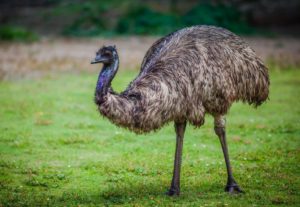
The magnificent emu (image from australian.museum)
The second largest bird behind the ostrich, the emu is the sole member of the Dromaiidae family, although they were once thought to be part of the order Casuariiformes until genetic studies from 2014 placed them in their very own family. They are part of a group of birds called the rattites, or flightless birds.
For many years, evolutionary scientists could not understand how flightless birds like the emu ended up on the isolated Southern Continents like Australia. Initially, it was believed that they all shared a single flightless ancestor that once lived on the supercontinent Gondwana that became isolated from each other when that ancient continent began to split as tectonic plates shifted. But when DNA isolated from the bones of the ancient Elephant Bird from Madagascar, it was discovered that their closest relative was the kiwi, the famous flightless bird from New Zealand. A bird from Madagascar with its closest relative in New Zealand made the Gondwana theory unlikely. Instead, scientists now think that a small distant ancestor must have had the ability to fly and made its way to distant continents. But another question was why these birds lost the ability to fly and then grew so large? After the extinction of the dinosaurs and before the rise of mammals, there was a period of time with few predators, and the birds could grow to enormous sizes without being eaten. This favourable environment gave rise to huge birds, like the ostrich and the emu.
Emus were first spotted in 1696 when explorers from Europe reached the Australian coast. There are three subspecies alive today, the Northern Emu, South-eastern Emu and Southwestern Emu, with a fourth extinct species, now extinct, from Tasmania. They are common throughout Australia in savannah woodland and forest adapted for hot, arid conditions, called sclerophyll forest. Some are found in more urbanised areas, but this is less common.
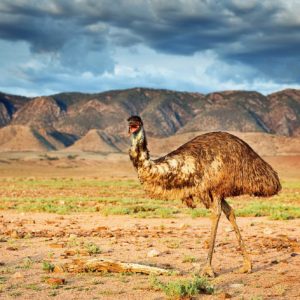
The typical arid habitat of the emu (image from www.thetimes.co.uk)
Big birds, big impacts: the ecology of the emu
Emus will forage for a variety of food, including fruit, insects and a range of vegetation, and they have even been known to destroy crops, even climbing over large fences to reach them! Their big appetite gives them an important ecological role too, as they are excellent seed dispersers for a variety of fruit and other plants. However, they haven’t always been so helpful, as they were involved in the huge, uncontrolled spread of the invasive prickly pear, a cacti that was introduced to Australia by colonists and quickly overtook the whole continent. Emus ate the prickly pears and pooped out their seeds across vast distances. But as is so often the case, nature provided a solution to the man made problem. Cactolastis cactorum moths were first released into the Australian environment in 1926, and their larvae hatched and fed on the prickly pear, destroying huge fields were previously there looked to be no hope in tackling the invasive plant.
Fueled by their diet, emus can run up to 48 kilometres per hour, thanks to their specialised limb musculature and their three toes with a powerful grip. These toes also have incredibly sharp talons, and similar to another large flightless bird, the cassowary, they use them to drive off attackers with a kick. Although emus are flightless, the emu still have vestigial wings, which still have a role, as they flap them during running to help stabilise themselves. They have fantastic hearing and eyesight, helping them to identify threats even from quite a distance. Their eyes have a nictating membrane, which is a secondary, translucent eyelid that blinks horizontally, protecting their eyes from dust in windy, arid areas.
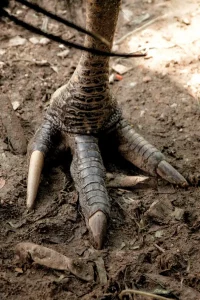
The powerful talons of the emu (image from www.thetimes.co.uk)
Emus will travel in pairs huge distances to find food, but large flocks of them are pretty rare, only seen when food resources are scarce. Emus have very few natural predators, with only really dingoes brave enough to try and hunt them, jumping at them and trying to lock their jaws around their necks. But emus can fight them off, using those aforementioned talons and powerful legs to kick them off. Aside from dingoes, wedge tailed eagles can attack emus, swooping at their heads where they can’t defend themselves, although they tend to only take smaller emus or their hatchlings.
A troubled history: the great Emu war
The common emu is the only survivor of several subspecies that were killed off by European settlers, although fortunately their populations today are healthy and they are listed as least concern by the IUCN. The King Island Emu once lived on King Island in the Bass Strait and was last seen in the wild in 1802, with the last captive individual dying in 1822. Another extinct emu species is the Kangaroo Island Emu, once found only on Kangaroo Island (very apt names for both species), was hunted to extinction in 1827.
Emus were an important source of food for indigenous aboriginals, and they practiced sustainable hunting by only killing out of necessity and using all the body parts, harvesting their fat for oil lamps, shaping their bones into knives and tools, using their feathers for body adornment and their tendons as string. This sustainable practice went by the wayside when European colonists reached Australia. They were hunted in large numbers until eventually early conservationists began to realise that the species would die off if hunting pressure wasn’t eased. In 1999, the emu was listed under the Environment Protection and Biodiversity Conservation Act. Although they are considered pretty stable today, they are still facing issues from fragmented and destroyed habitat, collisions with vehicles and predation on their eggs and young from invasive species like foxes and cats.
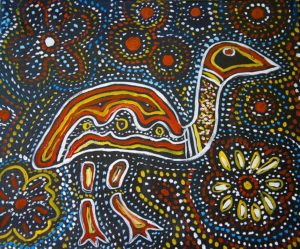
An example of aboriginal art celebrating the emu (image from fineartamerica.com)
Part of their troubled history with humans even involves a war! In 1932, the Great Emu War (yes that is actually its name) broke out. A long dry spell in the summer months led to a mass flocking of emus to the Chandler and Walgoolan area, drawn by the huge crop fields situated there. They tore through the area, pulling up crops at alarming rates and damaging rabbit proof fences, allowing the furry little menaces access to the crops too. Farmers, already facing a challenging year, attempted to scare away and shoot the emus, but it had no affect on the hordes of birds descending on the farms. Desperate, farmers called on the military, who attempted to first corral the birds away from the farms, which amounted to nothing as they simply split into smaller groups that were impossible to manage. The next step was to try and thin out the flocks of birds with sub machine guns. Although an estimated 2500 rounds were shot, there were minimal casualties. Eventually the birds dispersed without any input from the military. So I think its safe to say the emus actually won the war, even against sub machine guns! This war will go down in history as one of the most extreme examples of animal control ever seen, that was ultimately very unsuccessful!

Australian artillery personnel waging their futile war against the emu hordes in the Great Emu War of 1932
Awesome videos!
References
McGrath, R.J. and Bass, D. (1999) ‘Seed dispersal by emus on the New South Wales north east coast.’ Emu
Mitchell, K.J. Llamas, B. Soubrier, J. Rawlence, N.J. Worthy, T.H. Wood, J. Lee, M.S.Y. and Cooper, A. (2014) ‘Ancient DNA reveals elephant birds and kiwi are sister taxa and clarifies ratite bird evolution.’ Science
Patak, A. and Baldwin, J. (1998) ‘Pelvic limb musculature in the emu Dromaius novaehollandiae (Aves: Struthioniformes: Dromaiidae): Adaptations to high speed running.’ Journal of Morphology
The Great Emu War of 1932 | Everything You Need to Know! (nomadsworld.com)
Emu | Description, Habitat, Diet, Height, Speed, & Facts | Britannica
Emu Bird – Key Facts, Information & Pictures (animalcorner.org)
MASSIVE THANK YOU TO RACHAEL DA SILVA FROM THE UK FOR THIS WRITE UP! PLEASE FOLLOW HER ON INSTAGRAM AND HER WILDLIFE ARTWORK AT TILLY_MINT08


